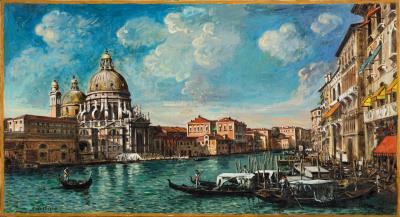Giorgio de Chirico *
(Volos, Griechenland 1888–1978 Rome)
Venezia (Canal Grande e Chiesa della Salute), c. 1955, signed; signed, titled and inscribed on the reverse, oil on canvas, 60 x 110 cm, framed
This work is registered in the Fondazione Giorgio e Isa de Chirico, Rome and is accompanied by a photo certificate of authenticity
Provenance:
European Private Collection
This view of Venice is a work from the mid-1950s, belonging to what we might call the late Baroque phase. In this period, the artist turned his gaze to the Flemish painting of Rubens and, especially, to the darker gradients typical of Tintoretto’s mannerist colours.
The 1950s were a period of great change for De Chirico: years that marked his definitive move to Rome; the mourning for the death of his brother Savinio and the series of works dedicated to the lagoon city – a city he had begun to discover and love ever since his first exhibitions at the Art Biennials.
From an iconographic point of view, the artist’s debt to the great masters of Venetian vedutismo is undeniable: Canaletto, Bellotto and Guardi in primis and their great attention to perspective representation. However, unlike the “capricci”, de Chirico’s works offer themselves as objective and truthful representations of a sometimes later but equally melancholic Venice, to paraphrase Aznavour.
The painting technique is also a salient characteristic of these series and indicates a more mature production. He turns away from the meticulousness and scientific rigour of Canaletto’s representations and towards a style of painting typical of the twentieth century. This is marked by broader backgrounds and brushstrokes that become denser and more mellow, at times Divisionist, as can be seen in the definition of the Grand Canal. Similarly, the chromatic tones become particularly intense, shaping decisive chiaroscuro contrasts, evident on the Chiesa della Salute and on the gondolas moored in the right-hand portion of the painting.
Yet even in this later phase – misunderstood at the time by the most avant-garde circles – that salient character that has always distinguished the painter seems to reappear: the attention to the temporal dimension. Even this Venice seems to live with a duration of its own, in an atmosphere that is always suspended and in a time that lyric poets would call “aionic”.
Zitat:
“It is a city of contrasts, a city that lends itself to painting, the city of painting par excellence [...] Whether it is an 18th- or 19th-century palace, Venice is always beautiful and I always think of it from a pictorial point of view”.
From an interview with Giorgio de Chirico by Franco Simongini, Venice, 1971
Specialist: Alessandro Rizzi
 Alessandro Rizzi
Alessandro Rizzi
+39-02-303 52 41
alessandro.rizzi@dorotheum.it
23.05.2023 - 18:00
- Realized price: **
-
EUR 299,000.-
- Estimate:
-
EUR 120,000.- to EUR 180,000.-
Giorgio de Chirico *
(Volos, Griechenland 1888–1978 Rome)
Venezia (Canal Grande e Chiesa della Salute), c. 1955, signed; signed, titled and inscribed on the reverse, oil on canvas, 60 x 110 cm, framed
This work is registered in the Fondazione Giorgio e Isa de Chirico, Rome and is accompanied by a photo certificate of authenticity
Provenance:
European Private Collection
This view of Venice is a work from the mid-1950s, belonging to what we might call the late Baroque phase. In this period, the artist turned his gaze to the Flemish painting of Rubens and, especially, to the darker gradients typical of Tintoretto’s mannerist colours.
The 1950s were a period of great change for De Chirico: years that marked his definitive move to Rome; the mourning for the death of his brother Savinio and the series of works dedicated to the lagoon city – a city he had begun to discover and love ever since his first exhibitions at the Art Biennials.
From an iconographic point of view, the artist’s debt to the great masters of Venetian vedutismo is undeniable: Canaletto, Bellotto and Guardi in primis and their great attention to perspective representation. However, unlike the “capricci”, de Chirico’s works offer themselves as objective and truthful representations of a sometimes later but equally melancholic Venice, to paraphrase Aznavour.
The painting technique is also a salient characteristic of these series and indicates a more mature production. He turns away from the meticulousness and scientific rigour of Canaletto’s representations and towards a style of painting typical of the twentieth century. This is marked by broader backgrounds and brushstrokes that become denser and more mellow, at times Divisionist, as can be seen in the definition of the Grand Canal. Similarly, the chromatic tones become particularly intense, shaping decisive chiaroscuro contrasts, evident on the Chiesa della Salute and on the gondolas moored in the right-hand portion of the painting.
Yet even in this later phase – misunderstood at the time by the most avant-garde circles – that salient character that has always distinguished the painter seems to reappear: the attention to the temporal dimension. Even this Venice seems to live with a duration of its own, in an atmosphere that is always suspended and in a time that lyric poets would call “aionic”.
Zitat:
“It is a city of contrasts, a city that lends itself to painting, the city of painting par excellence [...] Whether it is an 18th- or 19th-century palace, Venice is always beautiful and I always think of it from a pictorial point of view”.
From an interview with Giorgio de Chirico by Franco Simongini, Venice, 1971
Specialist: Alessandro Rizzi
 Alessandro Rizzi
Alessandro Rizzi
+39-02-303 52 41
alessandro.rizzi@dorotheum.it
|
Buyers hotline
Mon.-Fri.: 10.00am - 5.00pm
kundendienst@dorotheum.at +43 1 515 60 200 |
| Auction: | Modern Art |
| Auction type: | Saleroom auction with Live Bidding |
| Date: | 23.05.2023 - 18:00 |
| Location: | Vienna | Palais Dorotheum |
| Exhibition: | 13.05. - 23.05.2023 |
** Purchase price incl. charges and taxes
It is not possible to turn in online buying orders anymore. The auction is in preparation or has been executed already.
More objects by this artist
-

Estimate:
EUR 70,000.- to EUR 100,000.- -

Estimate:
EUR 30,000.- to EUR 40,000.- -

Estimate:
EUR 16,000.- to EUR 22,000.-

